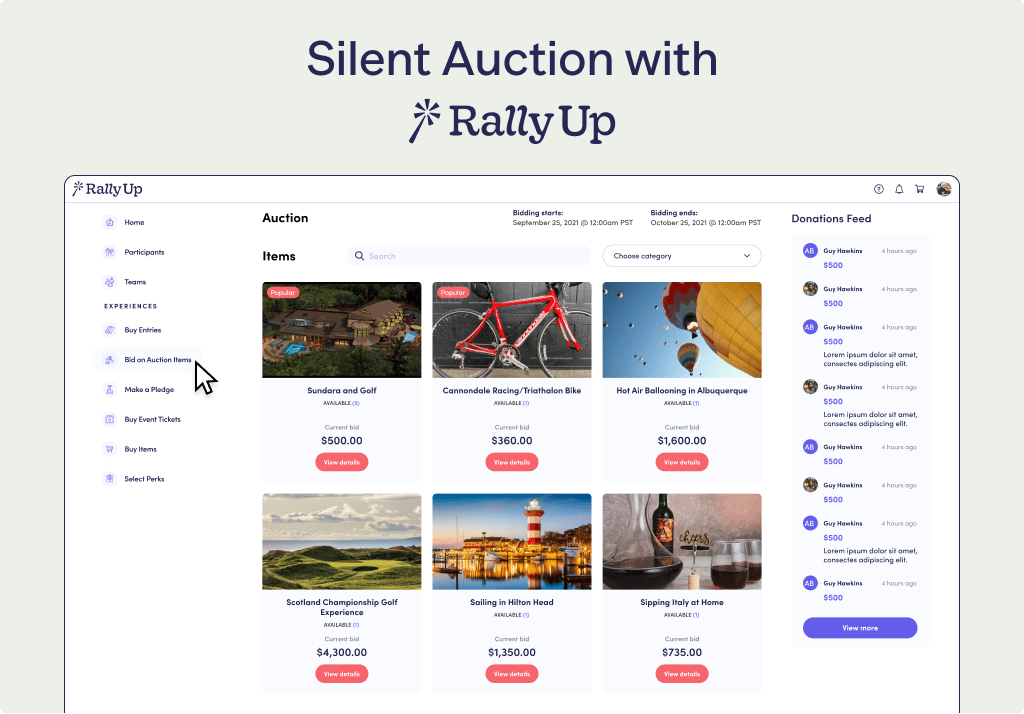Silent auctions are a little different to live auctions. In this easy guide for beginners, we explore what they are, how they work, and give you some amazing ideas for your first successful silent auction.
Auctions have been around for thousands of years, since the days of Ancient Greece. Traditionally an auctioneer would host a live gathering, accepting bids from the crowd on the item up for sale. The eventual sale was made when someone in the crowd bid an uncontested price.
For an auctioneer, competition and demand drive up the price for their auctioned items. Setting a minimum starting bid increases the chance that the item will sell for more than it is worth.
Just how much more is open ended.
These days, there are many ways to auction an item to a group of people, thanks to the introduction of new methods, technologies, and social trends. Silent auctions are one version of the archetype.
If you have a batch of items that you would like to sell, to raise money for a cause – the silent auction model might be exactly what you need. Below is a list of commonly asked questions that we are going to answer, one-by-one. Click the question to get fast answers, right here.
You can also start here to get a comprehensive guide on this lesser known, but extremely popular, type of auction. By the end of the post, you will have everything you need to plan, launch, and run a successful silent auction of your own.
Let’s get started!
What is a Silent Auction?
A silent auction is a type of English auction that offers items for sale through a private bidding process that is not hosted by a live auctioneer. Instead, bids are placed either on paper, or online. When the auction ends, the bids are closed and the highest bidder wins.
This type of auction is popular among charities in the non-profit fundraising space because multiple items can be auctioned off at the same time – within a predetermined period.
Much like in a traditional English auction (also called an open ascending price auction), attendees bid against each other for an item. But unlike the more common auction, there are some very distinct differences that make silent auctions unique.
A silent auction definition would be incomplete without mentioning that the ‘silent’ part of the term relates to the absence of the often animated and enthusiastic auctioneer.
Silent Auctions vs Live Auctions: What’s The Difference?

To fully understand silent auctions, you need to know how they differ from their live auction cousins. Aside from not having a fast-talking auctioneer setting bid increments and encouraging the participants to compete, there are some distinct disparities.
| Live Auctions | Silent Auctions |
| Auctioneer | No Auctioneer |
| Active Crowd Engagement (Live Bids) | Passive participation (Browsing, electronic bids) |
| Increasing competitive bids | Initial bid and review/rebid option |
| Public bidding | Anonymous bidding |
| Mainly in-person events | Mainly uses software online |
| Good for high end individual items | Good for a lot of general items |
| One-off events | Excellent addition to other non-profit events |
| Limited participant attendance | Unlimited participant attendance |
It’s important to note that with the advent of modern technology, live auctions can also be hosted online using livestream technology. It’s not uncommon for organizations to host a variation of both during one fundraising event to maximize the amount of money raised.
Why Host a Silent Auction?
Based on the differences above, you can see why silent auctions for charity are so popular. There are distinct benefits involved in running a silent auction that was not possible a few short years ago.
Before online platforms gave organizations the ability to centralize and easily control their auctions through mobile or web-based means – live auctions were far more profitable.
The logistics of organizing bids and rebids for multiple items were often not worth the money raised when these silent versions happened offline. The past decade has been a real gamechanger for organizations that have a lot of items to auction, but almost no time or budget to dedicate to it.
With virtually no experience, a single individual from a non-profit or company can successfully create, host, run, and manage a largescale silent auction without any trouble. Fundraising platforms have simplified this by automating a lot of what was once expensive and time-consuming.
Here are the core benefits:
- Expand your reach by having unlimited auction attendance
- Save money on hiring a location and an auctioneer
- Run the entire auction online using a flexible fundraising platform
- Promote your silent auction online in the event lead-up
- Auction dozens of items and raise money quickly
- Automate award and collections when the auction is closed
- Engage, retain and delight your donors
These silent auctions are incredible additions to other fundraising events.
If your organization is building an experience that raises money from various activities (raffles, sweepstakes, crowdfunding) then adding a silent auction could be a great fundraising mechanism.
It boosts engagement and gives donors a chance to support you in another way.
How Does a Silent Auction Work?
Now that you know exactly what these auctions are and what makes them different to live auctions, let’s explore how they work in two contexts – online or at an event.
How do silent auctions work online?
Online silent auctions vary, depending on the platform you use.
- Your organization will set up a silent auction page and list the items on offer
- A starting bid, and bid increments are set per item, along with an auction closing date
- You will promote and share your page everywhere to encourage participants to bid
- During the auction participants will bid on the items they like
- If they are outbid by another participant, they are notified by text
- Participants are given the chance to increase their bid or bid via proxy
- At the end of the auction, the highest bid wins the item
- Money is automatically collected from the winning bidder
How do silent auctions work at events?
In-person silent auctions happen during a live event.
- Items on offer are displayed or staged somewhere prominent for participants to see
- Minimum bid amounts and increments are set, along with a closing time
- Every participant is given a bidding number which they use during bidding
- People are able to browse the available items and write their bids on a bid sheet
- The paper bids are left on the table and are completely anonymous
- Participants are given a chance to review and increase their bids
- The winning bid is announced shortly after the auction closes
Both types of silent auctions can be run through a fundraising platform, and need to be promoted across social media and other advertising platforms to attract viable participants.
What are The Rules of a Silent Auction?
Luckily, there isn’t a long list of rules involved with setting up a silent auction of your own. They mostly follow these best practices.
Rule #1: Tier Your Items
Many organizations have donated or sponsored items to auction, but these need to be tiered to get the most out of your bidders. Generally speaking, tiers begin with the least expensive item to encourage more bids, and they increase in value as the participant browses. Always arrange your items from least to highest value, so that your donors are encouraged to view them all.
Rule #2: Set a Time Frame
Whether live or online, your silent auctions need a set timeline. Consider the promotional period that must come before the event, then how long the event itself will last. Live silent auctions are typically only a few hours long, while online versions can last hours, days, even weeks. The important thing is that you have a defined closing time that you can promote.
Rule #3: Set Realistic Minimum Bids
Your minimum bid is going to set the tone for all future bids on your item. If it’s too low, it might put off some of your bidders. If it’s too high, you might not get many bids. The goal is to find a happy medium that includes the value of the item but leaves enough room for fair bid competition.
Rule #4: Participant Bids are Anonymous
One of the most appealing features of a silent auction is that bids are private and anonymous. Your participants don’t have to go head-to-head in a public bidding war to secure the item they want. All they have to do is privately and discreetly outbid each other.
Rule #5: Stage Your Items
Your auction depends on the quality of your items. It can also depend on the visual depiction of your items. If you are running an online silent auction, invest some time taking quality images of your items for sale. Craft exciting descriptions, add video clips, and enhance their value.
These silent auction rules will help you put together an event that runs smoothly. Remember to dedicate someone to manage this process from start to finish.
What Items are Sold at a Silent Auction?
A key element in all silent auctions online is the items up for sale. Knowing how to conduct a successful silent auction is only half of the battle. The other half is knowing what people want to bid on. This means having access to items that will encourage donors to bid, not once, but many times.

Here are some items that work well:
- Fun experiences: Items like overnight stays, spa days, winetasting tours and ziplining are always a big hit at these events. If it’s fun to experience, it’s worth bidding on.
- Services: Companies donate their services to the auction to help you raise money. A year’s worth of yoga classes, or housekeeping, personal training, or pet sitting gets people’s attention.
- Random things: A parking space, seats in a school stadium, a day off, access to the football team, or band – creative items tend to get a lot of bids.
- Tickets: Auction off tickets to a show, a concert, a theme park, a series taping, backstage passes, or to awards show day, people love bidding on rare and exclusive tickets.
- New technology: Smart phones, iPads, DSLR cameras, televisions, retro boomboxes restyled as Bluetooth speakers. Get hold of some quality tech and auction it off!
- Gifts and Kits: A basket full of cupcakes, a pet emergency kit, a liquor cabinet, 100 lottery tickets, a kit for a campfire. Your participants will enjoy bidding on these fun prizes.
Nonprofits secure item donations and sponsorships from the community, religious institutions, businesses, and private organizations.
Understand how much money you would like to raise before getting the items you plan to auction. That way, you can make sure that the items will fit your requirements, encourage enough bids, and raise the funds you are targeting.
How Do I Run a Silent Auction?
There are many ways to run silent auctions these days, but how you go about it depends on your unique circumstances and needs.
- Budget
Your budget will impact everything from whether your auction is live or online, to how effective your promotions are at attracting bids. The reality is that most organizations will either have a strictly set budget or an extremely limited one. Understand your position and make decisions from there.
- Timeline
How much time do you have to pull this together? Take a minute to understand how long it will take you to put a fully-fledged silent auction together for your cause. Factor in any other fundraising experiences that are happening at the same time.
- Resources
How many people are going to be involved? Look at managers, sponsors, organizers, and marketers. Scale is the one thing that you can’t afford to forget about when dedicating resources to an auction. Be selective when choosing your silent auction software, and make sure it’s easy to use!
- Items
Decide how many items you are going to list, what they will be, and where you will get them from. Before embarking on your silent auction journey, you will need a strong idea of what you’re going to be auctioning to your participants. Prepare donation letters to send to potential sponsors.
Here is how to do an online silent auction with RallyUp:
Step 1: Sign-up
Login with your Facebook or Twitter account, or use your email address.
Step 2: Complete your Silent Auction Page
Choose to run an auction and populate your page with content. Give your auction a name, upload photos, videos, and other rich media – and add an introduction to tell your participants all about your fundraising event. Set your closing date and your timer.
Step 3: Add Unlimited Items to Your Auction
Create your item tiers and upload them to your page. There is no limit on how many items you can upload. Include some great images and add a description for each item to motivate bidders.
Step 4: Set Your Bid Minimum and Increments
Set your silent auction bid minimum for each item, and the increments available to your participants. The highest current bid will reflect on your auction page.
Step 5: Enable Outbid Texts
When a participant is outbid, you can enable automatic text messages that will inform them that their bid is no longer on top. This gives them the opportunity to return to the page and bid again.
Step 6: Launch Your Page and Promote It!
In just a few clicks your silent auction page is ready to go. Once launched and live, you can promote your page across your social media properties in a single click. Generate a special link to share in your marketing materials and newsletter. Get the word out about your auction.
Auction running at a live event? Here is how to make a silent auction bid sheet.
Which Silent Auction Ideas Work Best?
You have the scoop on how silent auctions work and which items are hot commodities for sale. Now what you need are a few ideas that will help you spark your own. After all, the best fundraisers are always based on a strong premise, a theme, or a collection of original ideas.
Here are our top 3:
#1: Themed Gift Baskets
Collect donations for a themed gift basket auction and assemble some truly incredible items. Each basket is a collection of themed items, which makes it easier for a company or sponsor to assemble. Plus, leaning into a theme makes the item more desirable for bidders.
Some popular and successful baskets include: a golfer’s gift basket, a craft beer gift basket, a plant-based snack hamper, a pet’s accessories gift basket, and a travel bug gift basket.
#2: The Team Gala
If you are raising money for a team, consider hosting a gala that has both a silent auction component and a live auction event. Focus your evening on auctioning team merchandise, experiences with the team, and special team-related perks. A big favorite is the date night live auction.
The trick to making your silent auction successful is to take advantage of the anonymous nature of the bidding process during the event. At the end of the evening, hand out the items to your winners!
#3: The High-End Auction
There are many categories of high-end items that can be auctioned especially well online. From holiday experiences to designer clothing, custom jewelry, and exclusive restaurant experiences – people enjoy getting something valuable and uncommon while contributing to a good cause.
Think laterally when putting together your high-end auction. Consider influencer or celebrity experiences, club access, or lessons with a golf pro. Make it something special and unique.
Silent auctions are fast becoming a staple fundraising strategy for organizations that need to keep their donors engaged and having a good time. This guide has walked you through the meaning of the term and has equipped you with some techniques and ideas on how to succeed.
We suggest running your first silent auction here and learning from the results. Our platform is designed to give you every chance of achieving your fundraising goals. With every campaign, you will gain a deeper understanding of how to build this strategy into your ongoing fundraising activities.
Whatever your next step, make sure that you have a strong idea and a reliable platform guiding you towards success. The rest is up to your participants!
